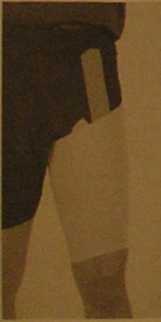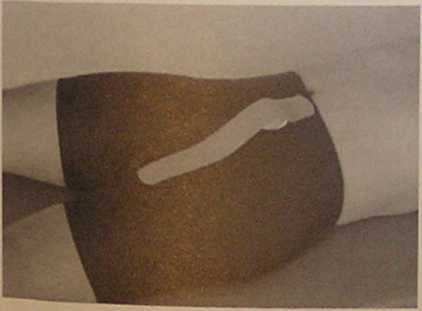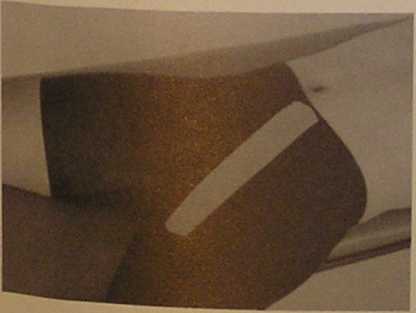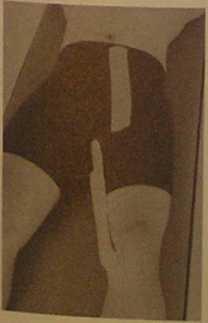P5140077

Quadriceps Strain/Conntusion Combination Technique " '"*•<!
Combination of thc Kinesio Taping Technique and use of a neoprene sleeve or elastic wrap may be found to be helpful in both the acute and chronię quadricep$ strain/contusion.
A strain to the quadriceps muscie group may result from ovcr-extension or over-contraction of the quadriccps mude group. If the muscie is acutely inflamed or weakend use the insertion to origin technque. If the muscie is chronically weakend use the origin to insertion method.
A contusion to the quadriccps muscie group necds to be treated with caution, as the largest muscie group in the body it has a significant blood supply and injury may result in bonę formation (myositis ossificans).
The use of the neoprene sleeve or elastic wrap may assist in limiting pain due to pressure created by elastic qualities of the products. Pressure around an injury limits pain possibly due to the initiation of the gate control theory of pain.
The length of tape application will be directly related to the patients care during application and removal of the neoprene sleeve or elastic wrap.
Completed application of the Basic Kinesio Taping Application of a quadriceps strain, origin t0 insertion, with space corrective techniąue. The practitioner may select to use either the basie application, the lymphatic correction, or both. For complete review see quadriceps contusion/strain.



Application of neoprene sleeve over the Kinesio Taping Method application.
Application of elastic wrap over the Kinesio Taping Method application. Use a 6" double length (10 yd) elastic bandage. Apply a spray adherent to reduce elastic wrap migration. Start application from the farthest point from the heart of the area to be covered. Do not apply with to much tension as to result in compromised drculation.
A strain to adductor muscie group commonly referred to as the groin is injured as the result of overex-tension or acute overload of the muscie tissue. It may involve the iliopsoas, rectus femoris, gracilis, pectineus, adductor brevis, adductor longus or adductor magnus. The practitioner will need to deter-mine which muscle(s) are involved and apply the appropriate Basic Kinesio Taping Technique.
The Kinesio Taping Technique will assist with reducing edema and pain.
For the acute muscie strains use the Kinesio I strip directly over the area of injury during the first 24-72 hours. Following this period use the Kinesio Y strip, with the tails of the Y, surrounding the injured area.



Basic Kinesio Taping method application of a iliopsoas (psoas major, psoas minor and iliacus) muscie using the Kinesio I strip. Kinesio I strip is placed directly over the area of pain.
Begin by placing the base of the Kinesio I strip above the umbilicus at approximately T12.
If using the altemative Kinesio Y strip technique, surround the area of injury with the tails of the Y.
Have the patient move into hip extension. Apply very light to light, 15-25%, paper off tension to the Kinesio I strip.
Direct the Kinesio I strip towards the lesser trochanter of the femur. Lay down the last 2-3 inches of the Kinesio I strip with no tension.
Initiate glue activation prior to any further patient movement.
Basic Kinesio Taping Method application of the common adductor muscie group (gracilis, pectineus, adductor brevis, adductor longus, and adductor magnus) using a Kinesio I strip. The Kinesio I strip is placed directly over the area of pain.
Begin by piacing the base of the Kinesio I strip as close as possible to the pubis symphysis and in/erior to the ramus of the pubis.
Wyszukiwarka
Podobne podstrony:
P5140080 Hamstring Strain Combination Technique Combination of thc Kinesio Taping Technique and use
P5140090 Patella Tendonitis Combination Taping/Bracing The practitioner may desire to use a combinat
P5140018 Functional CorrectionTendon Correction Application Technigue Use of tendon correction techn
P5140031 Completed example of possible Kinesio Taping Technique for shoulder instability -
P5140055 1Medial and Literał Epicondylitis Combination Taping The practitioner may desire to use a c
P5140088 Piitella Tendinitis - Combination of Kinesio Corrective Tecbniques Tho practiłioner may dec
P5140118 Metatarsal Arch Combination Techniąue LowDye Technique Completed application of the Kinesio
The optimal combination of less stringent restrictions with supplementary measures which keeps Rt be
[21J Oh K. S., and T. S. Kim: Performance analysis on various system layouts for the combination of
830D-IIJ IM TransmiUer The Collins 830D-1B FM Transmitter is a combination of excellent engineering
Open interfaces of GSMMobile Station (MS) The MS (Mobile Station) is a combination of terminal equip
strange combination of traditional European clothing and Native American dress, she is struck by his
79 capture, birds were banded with a USGS numbered metal band and a uniąue combination of three plas
Leadership is a potent combination of STRATEGY AND CHARACTER. But if you must be without one, BE WIT
72211 ScanImage006 -G-localization• Combination of standardization andlocalization in terms: -
więcej podobnych podstron